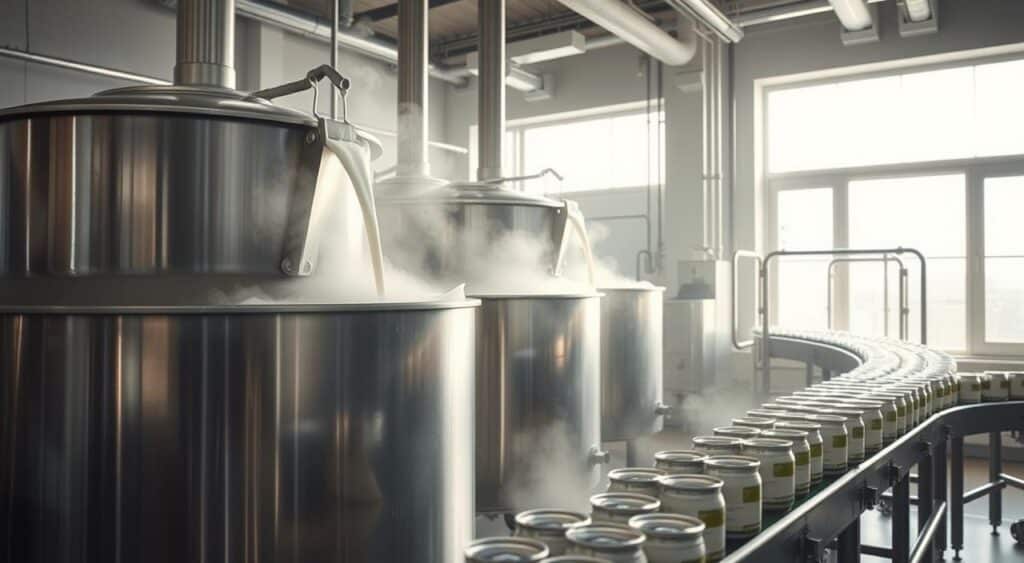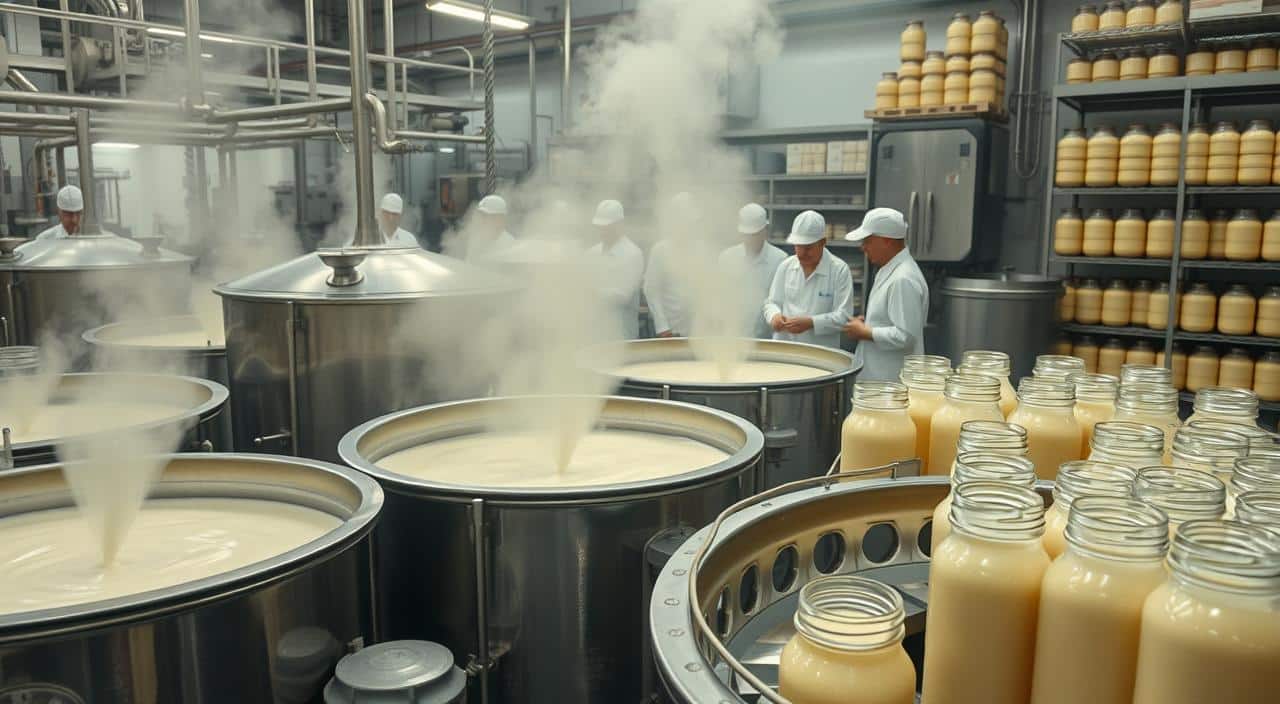Jump to:
Estimated reading time: 10 minutes
Table of contents
Making condensed milk is simpler than you might think. It’s easy for both professional chefs and home cooks. We’ll show you how to turn fresh milk into a sweet, creamy delight. You’ll learn about traditional and modern ways to make it.
It is a key ingredient in many sweet treats and drinks. Furthermore, it contains specific ingredients that create a sweet, thick milk, enhancing recipes. With just a few ingredients and some patience, you can make your own version at home.
Key Takeaways
- They make it by simmering and evaporating fresh milk to concentrate its flavor and texture
- The process involves standardizing the milk, heating and evaporating to concentrate the milk, and adding sweeteners.
- You can make it using whole milk, evaporated milk, or powdered milk as the base.
- Sweeteners like sugar are crucial for thickening and sweetening it.
- You can store it in the refrigerator for up to a week or longer when you make it with proper preservation techniques.
Introduction
It is a versatile and widely used dairy product. Moreover, it has captured the hearts and taste buds of people worldwide. This thick, creamy, and sweetened concentrate boasts a rich history, dating back to the 19th century.
People first developed it to address the challenges of milk preservation. Today, it is a staple ingredient in many recipes. People use it in both decadent desserts and savory dishes, showing its exceptional versatility.
In this article, we will explore the fascinating world of it. Specifically, we’ll delve into its production process, examine the different types available, and discover its role in culinary traditions worldwide.Whether you’re a professional chef, a passionate home cook, or just curious about food, this guide will give you a deep understanding of this iconic dairy product.
“Condensed milk is a rich, creamy, and indulgent ingredient that can elevate any dish to new heights of deliciousness.”
Furthermore, we’ll uncover the secrets behind making it and see how manufacturers select raw materials. In addition, we’ll explore how manufacturing processes give it its unique flavor and texture. We’ll also look at its health benefits, impact on the environment, and how to substitute it.
So, let’s dive in and discover the remarkable world of it, one spoonful at a time.

The Basics of Condensed Milk Production
What Is Condensed Milk?
They make it by removing roughly 60% of the water from fresh cow’s milk. Consequently, this makes it thick, creamy, and sweet. It’s shelf-stable and can last for years if canned and not opened. Today, most people call it sweetened condensed milk because it usually has sugar added.
A Brief History of Condensed Milk
The way to preserve milk by sterilizing evaporated milk in sealed containers started in the 1880s. Before that, in 1850, someone in America figured out how to keep evaporated milk fresh with sugar. Now, making it has become a big business. Consequently, manufacturers use new methods like continuous heating and aseptic packaging.
Types of Condensed Milk
There are two main types of it:
- Unsweetened version (also called double concentrated milk), which is a sterilized product that is light in color and has the appearance of cream.
- The sweetened version is basically concentrated milk with added sugar, resulting in a yellowish, high-viscosity product
| Characteristic | Unsweetened Condensed Milk | Sweetened Condensed Milk |
|---|---|---|
| Sugar Content | No added sugar | Typically 45% sugar |
| Fat Content | Around 8% | Around 8% |
| Solids-Non-Fat | Around 20% | Around 20% |
| Appearance | Light, cream-like | Yellowish, high-viscosity |
| Primary Uses | Baking, cooking | Confectionery, chocolate |

Raw Materials Used in Making Condensed Milk
The quality of the milk’s raw materials is similar to that of long-life milk products. Specifically, two key factors are the spores and bacteria in the milk and its ability to handle high heat without curdling. Therefore, manufacturers must carefully control the bacteria during production.
Fresh Milk
It mainly comes from fresh, high-quality cow’s milk. The milk must be clean and free from harmful substances. Manufacturers often use pasteurized milk to prevent curdling during the condensing process. You can also use other milks like goat or sheep milk.
Sweeteners and Preservatives
The sugar in the sweetened milk should be between 62.5% and 64.5%. This high sugar level helps kill bacteria and extend shelf life. Adding stabilizing salts like sodium phosphates also improves heat stability.
Stabilizers and Additives
Manufacturers adjust the amount of phosphate they add depending on the milk batch. Additionally, they add vitamins at this stage too. For dairy-free options, people use vegan milks like coconut or almond milk.
| Ingredient | Purpose |
|---|---|
| Whole Milk | The primary raw material for condensed milk production |
| Sugar | Sweetener that increases osmotic pressure and preserves the product |
| Sodium Phosphates | Stabilizing salts that improve the heat stability of condensed milk |
| Vitamins | Optional addition to enhance the nutritional profile |
| Vegan Milk Alternatives | Used for dairy-free condensed milk production |
The Condensed Milk Manufacturing Process
To begin with, the making of unsweetened and sweetened milk starts with precise standardization. This crucial step ensures the right consistency and quality. Next, manufacturers heat the milk to kill bacteria and prevent coagulation during sterilization.
Step 1: Milk Collection and Filtration
Firstly, the journey begins with collecting fresh, high-quality milk. Then, they filter this raw milk to remove impurities. This crucial step ensures the milk is clean and consistent for making it.
Step 2: Evaporation and Concentration
For unsweetened milk, the milk is heated and then concentrated by removing water. The concentrate is homogenized and cooled. Sweetened milk is also heated and concentrated before adding sugar.
Step 3: Adding Sweeteners
Sugar is added to sweetened milk until it reaches a 9:11 sugar to milk ratio. As a result, this high sugar content stops bacteria growth and keeps the milk fresh.
The right mixing equipment is key for making quality milk. Advanced mixing technologies help mix ingredients well, saving time and ensuring a great product.
“Traditionally, people made condensed milk by adding sugar to whole milk and evaporating excess water. In contrast, modern techniques incorporate skim milk powder, butter oil, and sugar into milk or water to achieve the desired consistency without extensive evaporation.”
Quality Control in Condensed Milk Production
Producing high-quality milk is key to keeping customers happy and meeting industry standards. Therefore, manufacturers use a strict quality control system from start to finish. This ensures the milk stays consistent, safe, and lasts a long time on the shelf.
Ensuring Proper Consistency
Homogenization is a crucial step in making it. It spreads the fat evenly in the milk, stopping it from clumping later. The pressure used in homogenization must be just right. Too much can ruin the milk’s proteins, causing them to coagulate during sterilization.
Sterilization and Pasteurization
For canned unsweetened milk, the concentrate is sterilized in an autoclave. UHT-treated unsweetened milk is first sterilized and then packed aseptically. Moreover, sweetened milk, with its high sugar content, doesn’t need extra sterilization after packaging.
Packaging and Shelf Stability
Furthermore, manufacturers usually package unsweetened milk in sterilized cans or UHT-treated paperboard packages. Sweetened milk doesn’t need heat treatment after packaging because sugar keeps it fresh for a long time. The cans are cooled before storage to keep the milk fresh even longer.
| Milk Type | Packaging | Sterilization | Shelf Life |
|---|---|---|---|
| Unsweetened Condensed Milk | Cans, Paperboard Packages | Canned: Sterilized in Autoclave UHT-treated: Sterilized and Aseptically Packed | Up to 15 Months |
| Sweetened Condensed Milk | Cans | No Additional Sterilization (High Sugar Content Preserves) | Up to 2 Years |
Differences Between Sweetened and Unsweetened Condensed Milk
It comes in two types: sweetened and unsweetened (also known as evaporated milk). The main difference is sugar. Sweetened milk has sugar added after evaporation. This makes it thick and caramel-like, great for desserts and drinks. Unsweetened milk does not have sugar and is used as a milk substitute or in coffee.
Key Differences in Production
The main difference in making sweetened and unsweetened milk is sugar. Specifically, sweetened milk gets sugar after evaporation. In contrast, unsweetened milk doesn’t get sugar and needs extra sterilization after packaging.
Uses in Recipes
Sweetened condensed milk is great for desserts, candies, and drinks like Brazilian brigadeiro, key lime pie, and Vietnamese iced coffee. Unsweetened condensed milk is used as a milk substitute or in coffee when fresh milk isn’t available.
Nutritional Variations
Sweetened condensed milk has more sugar than unsweetened, affecting its nutrition. It has more calories, carbs, and sugar. Unsweetened milk has more protein and fat. The choice depends on the recipe and diet.
“Substituting evaporated milk for condensed milk or vice versa is not recommended due to the differing sweetness and consistency, affecting the final dish’s taste and texture.”
The Environmental Impact of Condensed Milk Production
The dairy industry is focusing on being more sustainable. They aim to lessen their environmental footprint. This means better animal care, using less water and energy, and handling waste better.
Sustainable Dairy Practices
Moreover, the dairy industry is working to lessen the environmental harm from condensed milk. They’re looking into better ways to make it, such as using efficient systems and green energy.
Water and Energy Consumption
Condensed milk making uses a lot of water and energy. To cut down, they’re trying out new, better systems and green power.
Waste Management
Condensed milk making creates waste like water, packaging, and leftovers. The industry is focusing on managing this waste well. This includes treating water, recycling, and finding new uses for leftovers.
| Sustainable Practices | Benefits |
|---|---|
| Improved animal welfare | Enhances the well-being of dairy cows and promotes ethical production |
| Water and energy-efficient technologies | Reduces resource consumption and lowers the carbon footprint of condensed milk production |
| Effective waste management | Minimizes environmental pollution and promotes circular economy principles |
By adopting these green practices, the dairy industry hopes to lessen the harm from making condensed milk. They want to help make a greener future.
Frequently Asked Questions
How is condensed milk made?
Condensed milk is made by slowly heating milk to evaporate about 60% of its water content. Once thickened, sugar is added to create a sweet, concentrated mixture, which is then cooled and canned for long-term storage.
Is there a difference between sweetened condensed milk and regular condensed milk?
Yes, sweetened condensed milk has added sugar, while regular condensed milk may not. Sweetened condensed milk is the type commonly used in baking, as the sugar gives it a thicker, syrupy consistency.
What type of milk is used to make condensed milk?
Typically, whole cow’s milk is used for making milk, as its natural fat content contributes to the rich, creamy texture. However, low-fat or plant-based versions are also available.
Can you make condensed milk at home?
Yes, you can make milk at home by simmering whole milk with sugar over low heat until it thickens. It takes about 30-45 minutes to achieve the right consistency.
Conclusion
It has been around for over a century. It’s made by concentrating fresh milk, sometimes with sugar added. This makes it thick, creamy, and lasts a long time.
The way it’s made hasn’t changed much, but new tech and green efforts have improved it. These changes make it better for us and the planet.
This article looked at condensed milk’s history and how it’s made today. It talked about keeping quality high, the sweet and unsweet types, and how it affects the environment. It also showed how new sweeteners and better making processes are keeping it fresh.
As people want better, greener dairy, condensed milk’s future looks bright. With new tech and research, it will keep being a favorite in homes for years.






